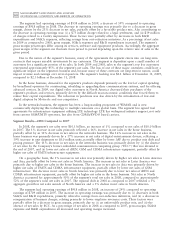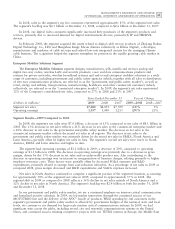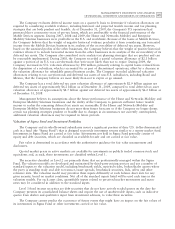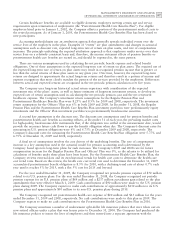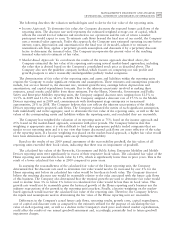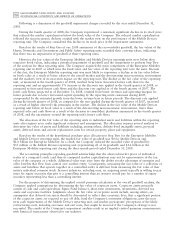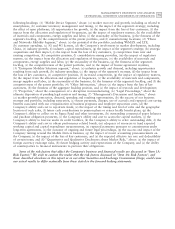Motorola 2009 Annual Report Download - page 78
Download and view the complete annual report
Please find page 78 of the 2009 Motorola annual report below. You can navigate through the pages in the report by either clicking on the pages listed below, or by using the keyword search tool below to find specific information within the annual report.
70 MANAGEMENT’S DISCUSSION AND ANALYSIS
OF FINANCIAL CONDITION AND RESULTS OF OPERATIONS
Following is a discussion of the goodwill impairment charges recorded for the year ended December 31,
2008.
During the fourth quarter of 2008, the Company experienced a sustained, significant decline in its stock price
that reduced the market capitalization below the book value of the Company. The reduced market capitalization
reflected the macroeconomic declines coupled with the market view on the performance of the Mobile Devices
reporting unit. The Company considered this decline in its stock price in the impairment assessment.
Based on the results of Step One of our 2008 assessment of the recoverability goodwill, the fair values of the
Home, Networks and Government and Public Safety reporting units exceeded their carrying values, indicating
that there was no impairment of goodwill at these reporting units.
However, the fair values of the Enterprise Mobility and Mobile Devices reporting units were below their
respective book values, indicating a potential impairment of goodwill and the requirement to perform Step Two
of the analysis for these reporting units. The Company acquired the main components of the Enterprise Mobility
reporting unit in 2007 at which time the book value and fair value of the reporting unit were the same. Because
of this fact, the Enterprise Mobility reporting unit was most likely to experience a decline in its fair value below
its book value as a result of lower values in the overall market and the deteriorating macroeconomic environment
and the market’s view of its near-term impact on the reporting unit. The decline in the fair value of the reporting
unit, as measured in the fourth quarter of 2008, resulted from lower forecasted future cash flows for the
reporting unit and an approximately 1% increase in the discount rate applied in the fourth quarter of 2008, as
compared to forecasted future cash flows and the discount rate applied as of the fourth quarter of 2007. The
lower cash flows, projected as of December 31, 2008, resulted from lower revenues and operating margins for
future periods due to lower forecasted capital spending by the reporting unit’s customers during 2009,
compounded by the estimated growth from the lower revenue base in future periods. The discount rate applied
during the fourth quarter of 2008, as compared to the rate applied during the fourth quarter of 2007, increased
as a result of higher observed risk premiums in the market. The decline in the fair value of the Mobile Devices
reporting unit below its book value is a result of the deteriorating macroeconomic environment, lower than
expected sales and cash flows as a result of the decision to consolidate platforms announced in the fourth quarter
of 2008, and the uncertainty around the reporting unit’s future cash flows.
The allocation of the fair value of the reporting units to individual assets and liabilities within the reporting
units also requires us to make significant estimates and assumptions. The allocation requires several analyses to
determine fair value of assets and liabilities including, among others, definite-lived intangible assets, pre-paid
assets, deferred taxes and current replacement costs for certain property, plant and equipment.
Based on the results of the hypothetical purchase price allocation in Step Two for the Enterprise Mobility
and Mobile Devices reporting units, the implied fair value of goodwill was $0 for Mobile Devices and
$1.0 billion for Enterprise Mobility. As a result, the Company reduced the recorded value of goodwill by
$55 million at the Mobile Devices reporting unit (representing all of its goodwill) and $1.6 billion at the
Enterprise Mobility reporting unit during the three-month period ended December 31, 2008.
The accounting principles regarding goodwill acknowledge that the observed market prices of individual
trades of a company’s stock (and thus its computed market capitalization) may not be representative of the fair
value of the company as a whole. Additional value may arise from the ability to take advantage of synergies and
other benefits that flow from control over another entity. Consequently, measuring the fair value of a collection of
assets and liabilities that operate together in a controlled entity is different from measuring the fair value of that
entity’s individual common stock. In most industries, including ours, an acquiring entity typically is willing to pay
more for equity securities that give it a controlling interest than an investor would pay for a number of equity
securities representing less than a controlling interest.
For the purpose of determining the implied control premium calculation in the overall goodwill analysis, the
Company applied assumptions for determining the fair value of corporate assets. Corporate assets primarily
consist of cash and cash equivalents, Sigma Fund balances, short-term investments, investments, deferred tax
assets and corporate facilities. Judgments about the fair value of corporate assets include, among others, an
assumption that deferred tax assets should be discounted to reflect their economic lives, that a significant portion
of the corporate assets are required to pay off debt, fund the Company’s retirement obligations, meet the near
term cash requirements of the Mobile Devices reporting unit, and market participants’ perceptions of the likely
restructuring costs, including severance and exit costs, that might be incurred if the Company’s strategy is not
successful. The results of the Company’s impairment analysis result in an implied control premium commensurate
with historical transactions observed in our industry.


